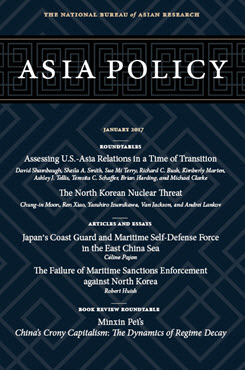Assessing U.S.-Asia Relations in a Time of Transition
Bilateral relationships in Asia present major opportunities and challenges for the new U.S. administration. This roundtable contains nine essays analyzing key U.S. relationships in the region—with China, Japan, the Korean Peninsula, Taiwan, Russia, India, Pakistan, Southeast Asia, and Australia—and identifying the most salient current and over-the-horizon issues in each dyad.
Introduction
Dealing with China: Tough Engagement and Managed Competition
David Shambaugh
U.S.-Japan Relations in a Trump Administration
Sheila A. Smith
Hazards on the Road Ahead: The United States and the Korean Peninsula
Sue Mi Terry
U.S.-Taiwan Relations in the Trump Administration: No Big Fixes Needed
Richard C. Bush
Trump and Putin, Through a Glass Darkly
Kimberly Marten
Avoiding the Labors of Sisyphus: Strengthening U.S.-India Relations in a Trump Administration
Ashley J. Tellis
Pakistan and the United States: A More Turbulent Ride?
Teresita C. Schaffer
U.S.–Southeast Asia Relations: Raised Stakes and Renewed Importance
Brian Harding
The U.S.-Australia Alliance in an Era of Change: Living Complacently?
Michael Clarke
Introduction
As a new administration takes office in the United States in January 2017, it will need to formulate policies to address a wide range of challenges in Asia. China continues to rise in terms of both material and economic power, causing the Sino-U.S. relationship to become increasingly competitive even as the two countries cooperate on issues such as climate change. U.S. allies Japan and South Korea worry about the growing nuclear threat from North Korea and question Washington’s continued commitment to the region, while relations between Taiwan and China have worsened since the election of Tsai Ing-wen in January 2016. In Southeast Asia, territorial disputes in the South China Sea are escalating as countries take increasingly aggressive actions to defend their claims. Australia, a long-time U.S. ally, is wary of U.S. retrenchment from the region and fears being forced to choose between the United States and China. In South Asia, Washington will need to balance its complex relationships with India and Pakistan, two bitter enemies that see any dealings with the United States by the other as detrimental to their own interests. Finally, Russia will continue to challenge the United States on a number of issues including cybersecurity and expansionism along its western border with NATO countries.
This Asia Policy roundtable contains nine essays analyzing key U.S. bilateral relationships in Asia and identifying the most salient current and over-the-horizon issues in each dyad. David Shambaugh posits that the United States must seek a responsible bilateral relationship with China that contains and manages the competitive issues between the two countries. Sheila A. Smith argues that the United States will need Japan’s help in both maintaining regional stability and engaging rivals like Russia. On the Korean Peninsula, Sue Mi Terry maintains that the new administration will need to apply greater pressure on North Korea while demonstrating stronger reassurances of alliance commitments to South Korea as the South navigates its own complicated political transition. Richard C. Bush’s analysis shows that Taiwan hopes U.S. commitments to Taipei will not erode under pressure from Beijing.
To the west, Kimberly Marten argues that the United States and Russia will continue to be at loggerheads on many issues, but because the new administration seems interested in another attempt at a reset, analyzing the future direction of this complex bilateral relationship produces more questions than answers. Turning to South Asia, Ashley J. Tellis assesses the U.S. relationship with India in the context of regional dynamics and argues that Washington should be careful not to derail its current path of improved bilateral relations with New Delhi. Teresita C. Schaffer, on the other hand, analyzes Pakistan as an unsteady U.S. partner whose strategic objectives rarely align and are often at odds with Washington’s regional goals. In Southeast Asia, Brian Harding observes that the Association of Southeast Asian Nations (ASEAN) is situated to become a focus of U.S. and Chinese competition for economic and strategic influence. Finally, Michael Clarke reflects on the U.S.-Australia alliance and sees a need for Canberra to facilitate more regional bilateral ties in the face of a potential shift in U.S. support.
As each of these authors observes, the United States’ bilateral relationships in Asia present major challenges, as well as opportunities, for the incoming administration. Taken together, the issues raised—which will often come into conflict across the different dyads—mean that Asia will have to remain the focal point of U.S. foreign policy in the years ahead. The roadmaps offered by the experts assembled for this roundtable provide a useful starting point for navigating these critical relationships.
About Asia Policy
Asia Policy is a peer-reviewed scholarly journal presenting policy-relevant academic research on the Asia-Pacific that draws clear and concise conclusions useful to today’s policymakers. Asia Policy is published quarterly in January, April, July, and October and accepts submissions on a rolling basis. Learn more


